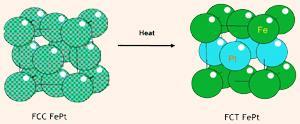UK scientists have made nanosized particles of iron-platinum, which are ordered on the atomic scale. They hope these will find a use in computer hard drives.
An interdisciplinary team of chemists, physicists and engineers from the Universities of Durham and Sheffield, UK, have found a way of making nanoparticles with an ordered arrangement of iron and platinum. John S O Evans and co-workers hope the magnetic particles will find use in computer hard drives.

Up to a point, increasing the information density of a hard drive depends only on the size of the particles: the smaller they are, the more data can be stored on a given area. However, when particles get too small, they can reach the superparamagnetic limit, where thermal energy is sufficient to randomise the magnetic alignments.
Fortunately for computer enthusiasts everywhere, this limit can be avoided by using materials in which it is very hard to change the direction of the magnetic moment, so that the information is not lost. Iron-platinum is known to keep its magnetisation direction, but only when the different metal atoms are distributed evenly throughout the particles. The only way to do this in the past has been by heating them to around 600?C, which has the drawback of increasing the particle size.
Evans and his team have been able to make particles of approximately 2nm using microwave heating to the relatively low temperature of 150?C. These are then converted to the crucial ordered material by heating to 300?C without the particles increasing in size.
The method already works for iron-platinum and iron-palladium and the team hope to extend it to other metals. Evans commented that the fact that this route allowed them to prepare ’FePt nanoparticles directly in solution, exactly as hoped, has been particularly satisfying.’
Neil D Withers
References
H L Nguyen, L E M Howard, S R Giblin, B K Tanner, I Terry, A K Hughes, I M Ross, A Serres, H Bürckstümmer and J S O Evans, J. Mater. Chem., 2005 (DOI: 10.1039/<MAN>b511850f</MAN>)






No comments yet